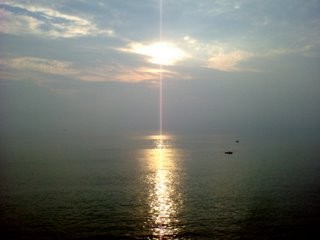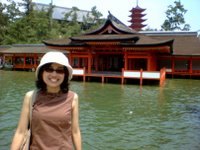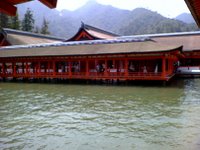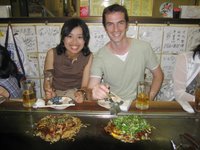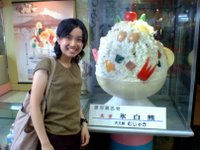David @ Tokyo
Perspective from Japan on whaling and whale meat, a spot of gourmet news, and monthly updates of whale meat stockpile statistics9/27/2006
2006 Whale meat stockpile movements
Traditionally anti-whaling propaganda attacked whale meat for being a "luxury" enjoyed by rich Japanese businessmen in flash sushi bars. For some reason this criticism has been dropped. It certainly didn't have any effect.
Based on media reports, I did some crude analysis of stock pile movements to get an idea of actual consumption trends earlier this year (here). I came to the conclusion that consumption in 2004 was roughly 3,900 tonnes or thereabouts, based on reductions in the size of the stockpile during the year. This was also probably an underestimate, since I assumed that the only whale meat coming on to the stockpiles was from research programmes, where as in reality whales that are by-caught can also be marketed legally as well.
Back during the early days of JARPA I, only up to 330 minke whales were taken annually, meaning that supply was less than 2,000 tonnes annually. 3,900 tonnes thus actually represents an increase in actual consumption in recent times. There was not 3,900 tonnes of whale meat available to be eaten back in the early 90's.
The Ministry of Agriculture, Forest and Fisheries of Japan publishes monthly statistics on the amounts of frozen whale meat in storage (amongst statistics for various other products). For those who can read Japanese, these can be found here.
The latest statistics were released on September 9, for the month of July. This was the first full month after the IWC 58 meeting. I went back a few months to when the JARPA II fleet returned, and took a look at what is happening in stockpile land:
| Month | Stockpile size at previous month end | Incoming stock | Outgoing stock | Stockpile size at current month end |
| March | 2898 | 1539 | 827 | 3610 |
| April | 3610 | 2920 | 561 | 5969 |
| May | 5969 | 129 | 357 | 5741 |
| June | 5741 | 163 | 414 | 5490 |
| July | 5490 | 905 | 1723 | 4672 |
The months of March and April see a huge influx of supply as the JARPA II research fleet returns at this time, and the stockpile peaks at this time (almost 6,000 tonnes this year). Again in July, I assume the relatively large influx of 905 tonnes comes from the initial stage of the JARPN II research (?), and the months in between see only small amounts of supply which is probably the results of whale by-catch.
What's really interesting though is the huge jump in whale meat shipped in July - 1723 tonnes. I looked back through a year's worth of these reports, and couldn't see any such seasonal precedent. Were that pace annualized, consumption would completely outstrip demand.
Could it have anything to do with the extra media attention due to the adoption of the St. Kitts and Nevis Declaration at IWC 58? Or perhaps the marketing efforts of the Geishoku Labo?
I'm not sure, but I'll certainly be looking out for the figures for August when they are published within the next couple of weeks.
It will also be interesting to see what the anti-whaling propaganda says (if anything) as any trend unfolds.
Labels: Japanese media perspective, stockpile figures, whale meat market, Whaling
Whaling - Anti-whalers support violence?
1) Say that you might not agree with whaling - but would you support acts of violence against whalers?
2) If you would, how far would you be prepared to take it? Where do you draw the line?
3) If you support people physically attacking whaling vessels, would you also support people attacking anti-whaling vessels?
4) If not, do you have any principles at all?
These are questions that I wish I could pose to the Australian people funding Sea Shepherd, one of whom is quoted in this article:
Australia's government apparently supports the "war on terror". Yet extremist groups that are known for their violent actions are able to receive such levels of support on the Gold Coast?"I think they're (Sea Shepherd) the most extreme whale-watching group in the world and we've chosen to fund them because we need some action taken on the whales".
"We really need someone to take extreme action to ensure that the whales are protected and kept safe."
"We're really happy to do that and we totally support it."
Some people need to get some perspective.
Labels: eco-terrorism, Whaling
9/26/2006
Slovenia joins IWC, membership count up to 71
Slovenia was slated prior to IWC 58 as one of the nations that the anti-whaling bloc was hoping would join, and this now looks to have eventuated.
A small country with a population of around 2,000,000, Slovenia has around 46 kilometres of coastline.
Labels: IWC vote influence, Slovenia, Whaling
9/25/2006
Whaling : Government refuses dolphin quota increase
Apparently of the nationwide quota of 21,120, Okinawa fishermen are allocated just 120. The prefecture issues permits for the hunting, but only 6 vessels are currently permitted. Some other fishermen are feeling disillusioned, as the 6 vessels have a monopoly over the hunt. Additionally, when the vessel owners retire they transfer the permits to their sons, which has created family monopolies over the fishery.
The prefecture has apparently been inundated with new dolphin hunting permit requests, but the central government, which regulates the hunt nationwide, has knocked back requests for quota increases.
The response from the Whaling Section of the Fisheries Agency was that "We will be reviewing the nationwide dolphin catch quota shortly, but according to recent scientific research, dolphin numbers aren't increasing, and thus it is unlikely that we will increase the catch limit. We can not cater to the Prefecture's request".
The article also notes that those fishers who do have permits note that dolphin hunting is a tough business that would be hard to make a complete living off. Apparently 70% of the catch is sold to Fukuoka where higher prices can be fetched for the meat.
My view: Naturally, in the absence of evidence increasing dolphin numbers the central government should not be contemplating quota increases. The article notes that only 76% of the quota is taken nationwide. Perhaps they might consider reallocating some of the quota to areas with higher interest, although this would need to be evaluated properly from a conservation perspective.
Labels: Whaling
9/24/2006
Summer Holiday 2006 - Day 7
We woke early on Friday in Beppu with the aim of getting ourselves to Hiroshima before the best part of the day was gone. We were again rewarded with a beautiful view from our hotel room balcony as you see in the picture above. We didn't have the best of weather for our time in Beppu, but this view left me with an overall good impression.
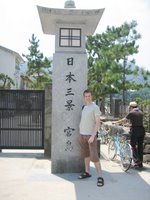 A train ride from Beppu took us through to Kokura, where we transferred to a Bullet Train, which promptly saw us leave the long Kyushu leg of our summer holiday behind as we arrived in Honshu by mid-morning. We had just one day planned here, so aimed to squeeze in the two main attractions: Miyajima and the Hiroshima Peace Dome and and museum about the nuclear bombs.
A train ride from Beppu took us through to Kokura, where we transferred to a Bullet Train, which promptly saw us leave the long Kyushu leg of our summer holiday behind as we arrived in Honshu by mid-morning. We had just one day planned here, so aimed to squeeze in the two main attractions: Miyajima and the Hiroshima Peace Dome and and museum about the nuclear bombs.We aimed to visit Miyajima first. In Japan there are three scenic spots ("nihon sankei") which were for some reason selected as "the three most beautiful" in Japan. Miyajima is one of these places. Matsushima in Miyagi prefecture (Northern Honshu) is another, which I have visited twice, and the other is a beach in Kyoto, I hear. Matsushima was quite good I thought, but I've heard the one in Kyoto is "over-rated".
Miyajima is an island near Hiroshima where there is a famous shrine which is built in shallow waters of the Seto inland sea. It was easy to get there from the city center, just take the JR line to get to the ferry port, and you're there pretty fast. There are JR ferries coming and going pretty much every 10 minutes so there's no need to worry about the schedules, and it's just a quick hop over to the island.
 Besides the shrine, today there are also huge volumes of tourist shops selling "momiji manju" and other local souvenirs, as well as heaps and heaps of little deer. During our time in Yakushima, Kana had told me that the deer there were really cute compared to the ones in Miyajima. That's a fairly accurate description, as the ones in Miyajima are basically scavengers waiting for doting tourists to give them a snack, and the place is covered in pooh as a result. They are much easier shots for the camera than the critters on Yakushima though, being accustomed to human activity (above).
Besides the shrine, today there are also huge volumes of tourist shops selling "momiji manju" and other local souvenirs, as well as heaps and heaps of little deer. During our time in Yakushima, Kana had told me that the deer there were really cute compared to the ones in Miyajima. That's a fairly accurate description, as the ones in Miyajima are basically scavengers waiting for doting tourists to give them a snack, and the place is covered in pooh as a result. They are much easier shots for the camera than the critters on Yakushima though, being accustomed to human activity (above). The most well-known site of Miyajima, at least in my mind, is the Torii entrance to the shrine, situated in the sea.
The most well-known site of Miyajima, at least in my mind, is the Torii entrance to the shrine, situated in the sea.Besides the Torii, there is the main shrine beyond that, which also sits in the water as well. Apparently when the tide goes out, you can actually walk around in the sand, but we found ourselves there with plenty of water about to prevent us. Instead we walked around inside the shrine complex (quite large too), and took lots of photos like all the other tourists:
We eventually headed back to the streets of tourist shops where I sampled a cream momiji manju. Very good it was too, and so I bought a box of them as a souvenir to take to the office.
It was probably around 2pm by the time we arrived back at Hiroshima, and we found ourselves walking from a train station along the tram route, over a bridge and then along a scenic walkway beside a river. The point of all this was to go to the Peace Park, see the memorial and museum there. As we came closer we could hear a thunder storm drawing near as well, and just as it started to rain a little we found the building with the dome which was apparently directly under the point where the bomb was detonated. The thunder storm was starting to get ominous, so we hurried to the museum.
There is not much that needs to be said here. No more nuclear weapons please, and let's get rid of what we've got.
After I guess 3 hours in the museum, we found that the rain had stopped and so took another look at the Peace Memorial monuments in the park, and then headed back to the city.
That evening we first checked ourselves into our hotel (which was quite cheap and reasonable), and asked the reception man about where we could find some nice Okonomiyaki restaurants. Okonomiyaki is one of my original favourite Japanese cuisines, although lately I've been steering more towards fish based dishes. The reception guy told us of a couple of places: one close to the hotel, one that was really tasty, and another building which was had nothing but okonomiyaki restaurants inside (probably where all the tourists go). We decided to go to the latter, which was probably a 15 minute walk from the hotel to the other side of town.
 When we got there, indeed we found it was a building that was full of okonomiyaki restaurants. "Okonomiyaki Paradise". With so many shops to choose from, how to decide which would be tasty? We went to the 4th floor first, and took a look around. Some of the shops were full of people already, where as some were almost empty, and the staff were beckoning us inside. Would you take up such an offer? I wasn't that hungry just yet, and convinced Kana that we should check around on the 3rd floor first. Eventually we decided that the shops on the 4th floor were probably a better bet, and we picked an almost full one, thinking the taste should be ok. The staff were some middle aged guys who looked what they knew what they were doing, where as the staff at some of the other emptier places were a little dodgy looking. They whipped up our orders in a jiffy:
When we got there, indeed we found it was a building that was full of okonomiyaki restaurants. "Okonomiyaki Paradise". With so many shops to choose from, how to decide which would be tasty? We went to the 4th floor first, and took a look around. Some of the shops were full of people already, where as some were almost empty, and the staff were beckoning us inside. Would you take up such an offer? I wasn't that hungry just yet, and convinced Kana that we should check around on the 3rd floor first. Eventually we decided that the shops on the 4th floor were probably a better bet, and we picked an almost full one, thinking the taste should be ok. The staff were some middle aged guys who looked what they knew what they were doing, where as the staff at some of the other emptier places were a little dodgy looking. They whipped up our orders in a jiffy: Hiroshima-style Okonomiyaki: basically a mix of cabbage, soba, some other goodies, okonomiyaki sauce and onions. Yummy!
Hiroshima-style Okonomiyaki: basically a mix of cabbage, soba, some other goodies, okonomiyaki sauce and onions. Yummy!We got back to the hotel and checked with reception about how long it would take to get to the ferry port from there. In the morning we planned to head over to Kana's hometown of Matsuyama. "About 30 minutes" we were told by the reception guy, but he didn't seem like he really knew what he was talking about. And indeed, that was the case as we found out the next morning...
Labels: Kana and I, Summer Holiday 2006
Whaling : The real threats to whales
But all this amounts to but 10% of the number of cetaceans estimated to die in fishing gear each year:
An estimated 300,000 whales, dolphins and porpoises die each year from entanglement in fishing gear, making fishing gear the single greatest human-related cause of cetacean mortality, according to the National Oceanic and Atmospheric Administration.
Alas, politics is more about focusing on symbols of far lesser significance (whaling) than rational management of such real conservation issues.
Labels: threats to whales, Whaling
9/23/2006
Whaling : NZ capable of respecting Pacific stance on sustainable resource use?
"a Pacific region that is respected for ... the sustainable management of its resources"
Kiribati, Nauru, Tuvalu have all made clear their support for the sustainable management of marine resources, the Solomon Islands is home to peoples who utilise small cetacean resources, and the Marshall Islands also has declared it's interest in international forums related to conservation of marine resources (apparently they eat turtles there - didn't know that!).
So remind me, where does New Zealand stand in all of this? Perfect timing - NZ Foreign Minister Winston Peters has just told the UN that
New Zealand had a commitment to the Pacific Islands Forum goal of a "region that is respected for the quality of its governance, the sustainable management of its resources, the full observance of democratic values and for its defence and promotion of human rights".
This sounds promising - New Zealand agrees with the idea of sustainable management of resources, just like it's neighbours in the Pacific Islands Forum. Perhaps New Zealand may display a more enlightened stance at next year's IWC meeting, in line with this commitment?
Winston also however made an interesting indirect reference to the situation at the IWC:
"New Zealand is determined to seek out the benefits of the Pacific's significance and guard against the threats – among which I include chequebook diplomacy."These comments are interesting from Winston. They seem to be largely compatible with the recent comments of Tuvaluan Prime Minister Maatia Toafa protesting suggestions from Murray McCully that New Zealand should seek to tie aid to votes:
"We are an aid-dependent country and we feel that we should be left to make our decisions without any influences"Rightly so. Winston also passed comment on McCully's musings himself:
Peters, who heads the country’s NZ$160 million Pacific aid programme, said New Zealand will “respect Pacific Islands countries as sovereign nations who make their own policy decisions.”Commendable. Winston presumably also thus supports the comments of Marshall Islands Marine Resources Authority, Glen Joseph made prior to the IWC 58 meeting, which noted that the Marshall Islands would make decisions
“Our preference is to talk with countries to understand their perspectives, rather than simply telling them they are wrong,” he said.
"on our own grounds and our own judgement of how the issues are presented at the commission"Winston presumably also accepts the 2005 call from Tuvalu that they be left to make their own decisions free of pressure.
We can but wait and see whether the rest of New Zealand's politicians and excitable media are able to develop such good sense prior to the IWC 59 meeting in 2007.
Winston made some comments on the whaling issue when speaking in Japan recently:
Responding to a question on the controversial topic of whaling, which has drawn strong comments from both Japan and New Zealand, the minister said he understood the description of the issue as a cultural one.One gets the impression that IWC meetings would proceed a little more smoothly and rationally if Winston were representing us there instead of our current delegation."My people have been in New Zealand over a thousand years," said Peters, who is half Maori. "We didn't just arrive there yesterday. And the indigenous people of New Zealand are Maori and they ate whales."
"We used to eat our pigeons too, and our kiwis and all our rare birds ... but we stopped because their numbers were diminishing. Not that we don't have a sweet tooth for that sort of food, but we just thought that with the interests long term and the character of our country, and these birds being important to us, we should change our ways."
"We make far more money out of taking tourists to watch whales, including thousands of Japanese tourists, than we'll ever make out of selling it as a fish meat on the market."
Labels: IWC vote influence, Tuvalu
9/21/2006
Whaling : Response to EIA's Claire Bass
Formalities
Thank you for your attention to our press release on JARPNIIEIA is more than welcome for the attention. As my regular readers know, exposing such propaganda as Claire Bass's recent effort is a frequent use that I find for my blog.
"EIA's statistics"
We are pleased you feel that our statistics require your defence!On the contrary, I didn't defend EIA's statistics (in fact derived from figures publicly released by the Institute of Cetacean Research, and more aptly described as "contortions"), I pointed out how scientifically meaningless they are.
Abundance estimates, and ICR survey data
In her comment, Claire Bass gleefully
- stresses that the IWC currently offers no abundance estimate for the Sei whale in the JARPN II research area, and
- thanks me for highlighting the IWC Scientific Committee's agreed abundance estimate for the North West Pacific and Okhotsk Sea minke, which has a lower confidence limit of 12,800, and
- proceeds to dispute that Japan's survey data is reliable, claiming that the IWC Scientific Committee has "heavily and regularly criticised" it for the last 20 years or so.
Yet Claire Bass would also have my readers doubt that Japan's survey data is reliable?
My readers might also like to consider whether Claire Bass is being truthful, in more general terms.
- The IWC homepage notes that in a review of the original JARPN programme in February 2000 "The Committee agreed that the information obtained was useful for management as it had been and will continue to be used in the refinement of Implementation Simulation Trials for North Pacific common minke whales."
- The Scientific Committee also noted with regard to the JARPA research that while "results were not required for management under the Revised Management Procedure (RMP), they had the potential to improve it..."
Given Japan's track record of producing sightings survey data suitable for estimating minke whale abundance, my readers will likely have confidence that the ICR's ongoing research programmes will produce reliable data to aid the IWC Scientific Committee in agreeing on an abundance estimate for Sei whales in the North West Pacific, and indeed other stocks as well.
I noted it in my original piece, and I'll note it again: Japan is actually fronting up with data, and it is being used by the IWC Scientific Committee. The EIA is fronting up with nothing other than meaningless statistics, catchy soundbites, and glossy propaganda videos.
"Clearly unsustainable"?
Despite having noted in my original piece that in all likelihood the number of anthropogenic removals from the minke stock by JARPN II lies within the range of 0.20% to 0.78% of the estimated abundance, Claire Bass still wishes to question whether the hunt is sustainable, and again fails to properly justify her original claim that it is "clearly unsustainable". She is yet to make any mention of essential biological considerations such as reproductive rates and natural mortality, and indeed the only grounds on which she criticised the sustainability of the catch is by comparison of the number of whales lethally sampled to the number of whales sighted which, as I have noted, is scientific nonsense.
Ummmm...
the majority of the Scientific Committee agree that you don't need to kill whales to count them!!Lethally sampling whales from a population is one methodology for obtaining information about biological parameters of that population, not estimating abundance, a fact which I'm sure the majority of the Scientific Committee is fully aware of, even if Claire Bass is not.
IWC Scientific Committee consensus
the IWC Scientific Committee has no consensus on the ...How could the IWC Scientific Committee have consensus on anything while the United Kingdom is actively appointing saboteurs from the EIA to it's ranks?
Where animal products come from...
On the other hand, you do need to kill them if you want to put them in cans and sell them in supermarkets..Of course it's obvious to anyone that consumes animal products that someone killing them first is a prerequisite for doing so.
Perhaps instead of embarrassing herself even further, Claire Bass might just drop her elementary grade analysis of the impacts of JARPN on whale populations, and just be honest and oppose whaling on cultural / moral grounds? Or indeed is it because those grounds are so shaky that she and her organization resort to scientifically nonsensical (albeit catchy) soundbites about "killing almost every whale in sight"?
Oh really?
We had considered a thorough response to the points made in your missive, but ... decided not to waste too much of our time.Yeah right, Claire...
So, we find ourselves at the end of the second innings, and I'm wondering if Claire Bass has the courage to try to dig herself out of the massive hole she now finds herself in, having made further easily disprovable claims about the ICR's research.
I guess the question is, just how many people does Claire think she can fool by keeping up her charade?
Labels: Claire Bass, EIA, Whaling
9/20/2006
Blogger Labels are teh good
I'll endeavour to use these as much as possible going forward, and try to categorize significant archived entries as I find myself refering to them.
For those of you who don't understand that, what it means is that if you don't want to sift through my whaling related posts to find the one's about my summer holiday, you can click on the "Summer Holiday 2006" link, and pull up just the pages I marked as being related to that topic.
Likewise, all you whaling debate lovers will be able to click on the "Whaling" label link, and I'll probably mark recurring sub-topics as well. I've only just started on this though, so it will take a bit of time to get into the swing.
At some point when I have a few free minutes I also want to add a links section, so you can easily find your way to other interesting sites that cover conservation issues such as Jennifer Marohosy's, Brendan Moyle's, as well as all those other good blogs out there that I would mention if it were not time for bed already.
9/15/2006
Whaling : Samoa again supports sustainable use
[Samoa's Prime Minister Tuilaepa Sailele Malielegaoi said] Samoa had made its position clear by declaring support for a policy in favour of marine resource sustainability in the Pacific region.Perhaps someone should tell Chris that there are whale-watching operations right here in Japan as well. Maybe it'll click for him eventually?"That means we support policies that will ensure the continuity and the proper balance of the existence of marine resources for the use of the people of the Pacific for the future," said Tuilaepa.
"That implies that if there is any killing [of whales], it should be on a level that will not result in an imbalance of the availability of resources and that the sustainability of marine resources will be maintained."
...
"New Zealand is saying the statistics are wrong but then New Zealand has not come up with proper research," said Tuilaepa.
...
Conservation Minister Chris Carter, who led the New Zealand delegation at this year's International Whaling Commission meeting (IWC), said he was "disappointed" by the remarks.
"There is a whale watch operation in Samoa and I think the Prime Minister seems to have been seduced by some of Japan's pseudo science," he said.
Meanwhile, Carter has also been busy rustling up a new "Diplomatic memorandum on whales in South Pacific".
Among South Pacific states likely to take part are Australia, New Zealand, Fiji, Cook Islands, Tonga, Samoa and Vanuatu, but a spokesman for the minister, Nick Maling, declined to confirm those expected to sign.I'd expect all nations to agree with this, since everyone agrees that the proper conservation of dolphins and whales as a Good Thing.
Carter said there is a high level of support among Pacific people for conserving whales and dolphins. "It doesn't stop Japanese whaling, but ... it enhances the protection particularly of dolphin species, which aren't so migratory," he told National Radio. "Until now the primary international forum for discussing whale conservation has been the International Whaling Commission, which is widely regarded in the Pacific as outdated, deadlocked and expensive for poorer countries to join and attend," he said in a statement. The memorandum, under the Convention on Migratory Species, "provides a new, more attractive and affordable alternative to the IWC for Pacific countries interested (in) pursuing whale conservation," he added.Carter is clearly worried about more Pacific Island nations joining the IWC and voting in accordance with the principle of sustainable use, and trying to give them as much reason as possible not to.
[UPDATED] Sir Geoff Palmer, New Zealand's IWC Commissioner has talked this up as well:
The commissioner, Sir Geoffrey Palmer, says it will give the group a significant amount of power to protect whales over a large area.So, in his view this is not a memorandum about conservation of whale species, but a memorandum about "preserving" individual whales which, as happens in nature, will all die and be replaced by offspring over time anyway.
He says it also means countries will not be able to resume commercial whaling in the area covered by the agreement.
That Sir Geoff believes commercial whaling will be prevented from resuming in the "area covered" indicates that the agreement only covers each nations' EEZ. Meaningless again for commercial whaling, since it all takes place in Antarctic waters anyway. If this is the idea behind the memorandum, then it may get less support than I previously thought, as people in some nations in the region (Tonga for example) are clearly interested in using whale resources as food, in addition to conservation. Let's wait for the answer to this later today.
[UPDATED AGAIN] Chris Carter gets heckled in parliament:
That's my beloved New Zealand parliament for you :-)Hon Marian Hobbs: What are the strengths of this new agreement?
Hon CHRIS CARTER: New Zealand is a leading conservation nation, like the UK. This memorandum, under the convention on migratory species, provides an effective alternative to the International Whaling Commission for Pacific countries interested in pursuing whale and dolphin protection. A significant feature of it is that non-governmental organisations can now join, providing a united voice on marine mammal issues. I just heard Judith Collins call out: “Boring!”. I support conservation; I thought that member would, too.
Judith Collins: I raise a point of order, Madam Speaker. I take offence to that comment. I did not call it out and I do not find conservation boring, even if that Minister is.
Madam SPEAKER: Thank you for clarifying that. That was not a point of order, and it was also compounded by the member making a flippant statement. I remind members on all sides of the Chamber that when they are making points of order, or when they are asking or answering questions, they should stick to the point. [Interruption]Hon Dr Nick Smith: I raise a point of order, Madam Speaker—
Madam SPEAKER: The member will please be seated. I understood that the member was clarifying that she had not made that statement, and that she did not find the subject boring but found the Minister boring. If she is in fact asking for the Minister to withdraw his comment that she had called out “Boring!”, then I would ask him to withdraw it so we can move on.
Hon CHRIS CARTER: I do apologise. I thought that voice was unique, but it clearly is not.
Madam SPEAKER: No, you will just reply. I ask members to please be silent, so we can move on.
Labels: Whaling
Whaling : Ian Campbell gets angry, again
This is not new. Whalers in particular have noted for years that pollution is a concern for whale populations, and the IWC's Head of Science, Greg Donovan told the BBC recently that "The greatest threats to them now are bycatches in fishing gear, collisions with ships and potential damage to their habitat." Not whaling.Researchers at the University of Tasmania are looking at the global whaling debate, the role of the International Whaling Commission (IWC) and Australia's policy position.
Researcher Mike Iliffe says commercial whaling issues are dominating the IWC at the expense of the real threats to the mammals.
"We really have to tackle global warming and pollution to a lesser extent," he said.
"Pollution may be killing 10 to 20 times as many whales as the Japanese, the Icelandics, the Norwegians and the aboriginal whalers together are killing right now."
Dr Julia Jabour says the polarisation of the pro-whaling and anti-whaling groups is making the commission dysfunctional.
"The debate has been impoverished because of an excess of emotion over rational argument," she said.
"When you listen to some of the arguments that the anti-whaling countries put forward they are based on cultural or moral high ground and I would suggest that that's pretty shaky ground to be on."
But apparently "environment" minister Ian Campbell thinks he knows better. His initial comments fail to properly address the issues raised by the researchers. He later threw a wobbly while talking to the ABC:
IAN CAMPBELL: I haven't heard anything more outlandish, and I think they their opinions would be offside with 99-plus per cent of the Australian population.Settle down, Ian. No need to go shooting the messengers. Here's Mike Iliffe again:
MIKE ILIFFE: I think there needs to be an agreement on what are the real issues, and if the IWC could just focus on things like global warming, pollution of the oceans, netting, underwater noise and so on, that really are threatening whale populations, then maybe we could put the hunting issue aside as being irrelevant or insignificant in the overall scheme of things in a sustainability sense. Then they could get on with dealing with the real issues.Ian wasn't listening, apparently, running off on an unrelated tangent:
IAN CAMPBELL: There is no humane way to kill a whale. The latest research by Tasmanian scientists at the Australian Government's Antarctic Division shows that the average time to death in the Minke whale hunt this year was upwards of twelve minutes. That's an animal suffocating and drowning, often in its own blood, for in excess of ten minutes. Any scientist who supports that shouldn't be in the business.Yadda yadda yadda, leaving Ian's dubious time-to-death figures aside, the researchers are not stating support for whaling one way or another - they're just pointing out the greatest threats to the conservation of whale species today which, as these researchers and IWC scientists say, realistically does not include whaling.
Labels: Ian Campbell, threats to whales, Whaling
9/13/2006
Whaling : The market - Japanese perspective 2
"Sell that whale meat!"[UPDATED: 09/14] My translation is completed now, and having done so I realize that Yomiuri's English version already have their own translation. It's worth reading anyway to see the contrast with mine. Some interesting things to note:
Whale upgraded to Izakaya regular / promoted in catered lunces
Food companies and restaurants dealing in whale meat are increasing. This is due to whaling interests getting serious about expanding consumption as whale meat stocks, marketed as food, have increased.
Whale meat sales are an essential source of revenue for research whaling. This is an urgent matter for interested parties, as further research whaling may be hindered if whale meat consumption is not increased.
(Takeo Miyazaki)
+ Health Food PR +
Whale meat eaten by consumers is mainly that of whales caught in research whaling which are subsequently processed and sold. The Foundation conducting research whaling, the Institute of Cetacean Research markets the meat through Kyodo Senpaku, the Tokyo-based company to which the actual whaling operations are contracted out to.
Recently Kyodo Senpaku and others have been strengthening their sales efforts, and instances of foodstuff companies and restaurants starting sales of whale meat are increasing.
Since March, Nippon Ham subsidiary company Hoko Co. Ltd. has been selling 3 types of new whale meat products, such as boiled retort and canned yakiniku. Hoko expects the products will be accepted if they are able to remind baby boomers of the flavour of the whale meat that they ate in the past.
Last November, Chimney Group added 7 whale meat items, including tatsuta-age and whale sashimi, to the menu at all of it's 200 "Hananomai" seafood izayaka-style restaurants. Previously these items had been seasonal offerings, but they have now had a "status upgrade" to regulars on the menu. The price of whale tatsuta-age is 50% higher than chicken kara-age, but it's said to be amongst the 10 most popular products in terms of earnings.
Elsewhere, major food retailer Maruetsu has had 10 products including whale sashimi on sale since June last year.
The Institute of Cetacean Research and others are also aiming to increase sales routes, and in May this year established a private company "Geishoku Labo" in Tokyo, which is selling whale meat to the catered lunch market including hospitals and universities.
Geishoku Labo representative Hiroshi Nakata promotes whale meat, saying "It's high in protein, and low in calories. The old image of it being a tough meat has been addressed through advances in freezing technology".
Glut of the "forgotten taste"
+ Stocks double in 10 years +
The reason for urgency in selling whale meat is because the supply of whale meat products has increased greatly, but consumption has been stagnant.
The Institute of Cetacean Research has increased the number of whale species taken subject for the purpose of detailed research into current population statuses, which has seen the supply of whale meat increase from 2450 tonnes in fiscal 2000 to 5560 tonnes in fiscal 2005.
However, consumption hasn't increased as expected. The International Whaling Commission decided on a temporary pause (moratorium) on commercial whaling in 1982, and as Japan ceased commercial whaling in 1988, average whale meat consumption per person has dropped from approximately 2000 grams 40 years ago to approximately 50 grams in 2005.
As a result, the annual average whale meat stocks stored in refrigeration increased by 45% on the previous year in 2005 to 3945 tonnes, approximately twice the size of 10 years ago.
Last year in December, the Institute of Cetacean Research which sets wholesale prices also reduced them by 20%, and this year from January through July, whale meat sales increased by 50% compared to last year, but stocks have not yet been reduced.
The Fisheries Agency Whaling Division sees a contributing factor as consumers having developed an image of whale meat being difficult to obtain, in a the phenomenon of the younger generation shying away from whale meat has also been identified.
Unsold stocks... problems for research whaling?
Of the 6 billion yen annual costs of research whaling, about 90% is paid for by whale meat sales. As such, if whale meat doesn't sell, this may have an impact on research whaling plans.
As the Institute of Cetacean Research also plans to increase the number of whales taken for research from fiscal 2007, forecasts are that supply of whale meat to the markets will increase to an annual 7,000 to 8,000 tonnnes. If consumption doesn't increase, and stocks build up further, there is a concern that funds may be insufficient to cover the research costs.
Additionally, Japan is pressing for a resumption in commercial whaling at the IWC. At this year's annual IWC meeting in June, a declaration sponsored by Japan and other whaling supporters was adopted with a 1 vote majority, including words to the effect that the temporary pause in commercial whaling is "unneccessary". However, if it seems that consumption isn't increasing smoothly, this may have repercussions in the international debate surrounding whaling.(2006/09/05 Yomiuri Shinbun)
- In the English version's headline they include the words "demand sluggish". The Japanese article says no such thing, and indeed the article notes that a range of outlets have introduced whale meat products, and notes that consumption is up by 50% year on year.
- Throughout the English version they talk about "demand" whereas the original Japanese version uses the word for "consumption". Perhaps Yomiuri has a "translator creativity" policy? Or perhaps it's just a case of telling their English readership what they think they want to hear.
- If you look at the URL's, the Japanese version of the article is posted in the gourmet section - the English version is posted under "national" news :-)
Labels: Hananomai, Japanese media perspective, Whaling
9/12/2006
Whaling : The market - Japanese perspective
In more recent times, the message is confused. On one hand the western media still refers to whale meat "the delicacy", yet on the other hand there is a fresh line that tells western readers that no one wants to eat whale meat anymore, and grossly exaggerated claims of whale meat being turned into pet food abound.
The Asahi Shinbun ran a story over the weekend in Japanese, which I've translated below. There appears to be quite a gap in the understanding of the situation between local Japanese commentators and their western counterparts...
Whale meat abundance - Fisheries Agency in all out marketing effort, but prices highThe Yomiuri Shinbun also ran another story about restaurants increasing the use of whale meat on their menus last week. I'll look to translate that sometime as well.
2006 / 09 / 10 - 13:37
Whale meat is piling up. This is due to the drastic reduction in sales channels following the 1988 cessation in commercial whaling, in contrast to increasing supply from expanded research whaling programmes. As the Fisheries Agency looks to market the by-products as "health food" to schools and hospitals, schools and the restaurant industry have been seen introducing whale meat in lunches and new dishes. However, state circumstances require that the wholesale price of the meat, proceeds of which are required to cover the costs of research whaling, cannot be lowered, meaning that there is still a long way to go before prices are at a level where whale meat can easily be enjoyed at household dinner tables.
A base for the marketing of whales caught in the deep-seas is a room in a high class apartment building in Roppongi, Tokyo. "Geishoku Labo" is a new company established in May with the backing of the Fisheries Agency. Here at a large table in the reception room, customers are served with whale dishes.
"Everyone is surprised - 'Did it used to be so delicious?'" says company president Hiroshi Nakata. He says that whale meat is popular for it's low calories and cholesterol, with several retailers providing hospitals, schools and company cafeterias with lunches having displayed an interest.
A large cafeteria operator, Nikkoku Trust of Tokyo, has plans to use whale meat for it's special menu. "It should be popular amongst older people for it's nostalgic taste, and amongst younger people for it's intrigue. But it's still expensive so we can't use it as a regular menu item", said a company representative.
Behind the establishment of the new company is a "whale surplus".
With the expansion of research whaling, whale meat supply is now more than twice the level of a decade ago.
However, in the 20 years since the cessation in commercial whaling, the majority of marine product wholesalers have ceased to deal in whale meat, and thus distribution has not kept up with these increases.
Due to this, at the end of last year the whale meat stockpile stood at 3,900 tonnes, equivalent to annual supply. Next year with a further expansion in whaling, an additional 1,500 tonnes is forecast to be taken, bringing the total catch to 5,500 tonnes.
There are also moves towards utilizing the extra whale meat. In Wakayama, in an effort to pass on local traditions that flourished based around old style whaling, around 70% of primary schools will be including such menus as whale meat tatsuta-age in school lunches once every 2 months from this fiscal year. There is also an expansion in the capital region, and according to Tokyo's Japanese Whaling Association, approximately 3,500 schools nationwide now include whale meat in lunch menus.
Lucky Pierrot, a hamburger restaurant with shops in the area around the research whaling mother port of Hakodate, Hokkaido, has been selling whale meat hamburgers for 380 yen since last year. Amongst the 20 or so types of burger on offer, it is the 2nd most popular. "We only just turn a profit on it. But we hope to continue to support our food culture" says the managing director, Miku Oh.
However, despite these moves whale meat is not often seen on the street. Even where it is sold, 100 grams typically costs 450 yen. In a store specialising in marine products, popular bacon blocks were on sale at the high price of 2,500 yen per 100 grams.
Sales of the whale by-products go towards financing research whaling. The wholesale price of whale meat, set each year by the Fisheries Agency in order to cover the annual whaling costs of approximately 6 billion yen, is now half the price at it's peak, down to 2,000 yen with the increase in supply.
However, supply is still limited, and standard retail prices are 3 times as high as wholesale. The government is unable to lower the wholesale price due the requirement to cover whaling costs.
Nakata of Geishoku Labo smiles wryly, "The Fisheries Agency is telling me that 'we want you to sell the meat but don't overstimulate the market'". There is a desire to re-establish distribution channels with an eye to the resumption of commercial whaling, but even so for the foreseeable future, as supply is limited, there is a concern that too much demand would result in supply not keeping pace.
There are also concerns that overheated Japanese demand, which in the case of tuna beckoned over-exploitation overseas and illegal trafficking, could result in a deterioration of recovered whale resources. "We don't want to repeat the tuna mistakes, but we'd like to supply whale meat to households at at least prices comparative to tuna," says Hideki Moronuki of the Fisheries Agency's Whaling section.
(ends)
Labels: Japanese media perspective, whale meat market, Whaling
9/10/2006
Summer Holiday 2006 - Day 6
Anyway, from Oita we jumped on a train and headed to Beppu, one of the most famous hot spring towns in all of Japan - the Rotorua of Japan to you New Zealanders reading this.
On arrival first priority was breakfast, but at this time of day in a tourist town there aren't all that many places to eat. We headed east from the station towards the waterfront area, lined with hotels, in search of some kind of morsel. Eventually, after coincidently locating the hotel where would stay this evening along the way, we found a Gusto store, which Kana tells me is basically a 24-hour restaurant chain that you can always depend on in such times of need. Yay for Gusto! After having a nice cheap breakfast there, with lots of orange juice and milk tea, we headed back towards the station, in search of a public bath. The lady who served us at Gusto told us that we could find one back towards the station which should be open at this time.
 Sure enough we found it, and got washed up. It was just a plain old standard bath, nothing flash at all - only about 200 yen or so. I was amused by another foreign tourist guy who turned up there just as I was getting out. It seems he was looking for something a little more classy, as he spent but 30 seconds in the washroom before leaving, with a mutter of "this sucks" on his way out. You can't please everyone! I was happy for the bath after the night on the bus.
Sure enough we found it, and got washed up. It was just a plain old standard bath, nothing flash at all - only about 200 yen or so. I was amused by another foreign tourist guy who turned up there just as I was getting out. It seems he was looking for something a little more classy, as he spent but 30 seconds in the washroom before leaving, with a mutter of "this sucks" on his way out. You can't please everyone! I was happy for the bath after the night on the bus.Anyway, after cooling off on the 2nd floor of the bath house for an hour, we headed back towards the train station. From here we'd take a bus to the other side of town, where there are a range of hot spring type attractions and little mini zoos.
This is Beppu's famous "Jigoku-meguri". There are 8 different attractions, each with their own hot pools (just like Rotorua, but these places were mostly concentrated together in walking distance).
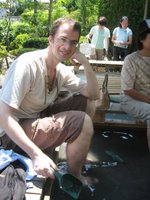 Many of them also have animals. We saw crocs (or alligators?), elephants, hippos, not to mention man-eating piranna fish and some others as well. There is a pass ticket with which you can see all 8 attractions, so we bought that planning to go around and see the entire lot. Along with souvenir shops, there is also the occasional foot bath to enjoy as well. In shorts and sandals, I took advantage of each opportunity.
Many of them also have animals. We saw crocs (or alligators?), elephants, hippos, not to mention man-eating piranna fish and some others as well. There is a pass ticket with which you can see all 8 attractions, so we bought that planning to go around and see the entire lot. Along with souvenir shops, there is also the occasional foot bath to enjoy as well. In shorts and sandals, I took advantage of each opportunity. To the right - "beauty and the beast".
To the right - "beauty and the beast".That was the Hippo's best pose. Mouth open, waiting for potatoes from tourists.
 I found it to be somewhat pitiful watching these animals reduced to feeding in an almost brain-dead fashion on whatever food it was that the tourists were able to purchase to give to them.
I found it to be somewhat pitiful watching these animals reduced to feeding in an almost brain-dead fashion on whatever food it was that the tourists were able to purchase to give to them.The elephant too just stood around sucking up the biscuits thrown to it, or in the case of tourists with long arms, hand fed.
I decided (again) that it was much more enjoyable watching animals in their natural environments, as was the case back on Yakushima. There, people could observe the animals in their natural environment, yet the animals were fending for themselves, rustling around for food by themselves, living a normal animal life in their habitat.
Still, it's always interesting to see such "wild"life.
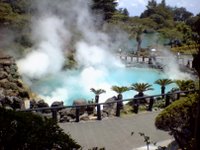 It's quite a different style of hot pool here in Beppu compared to Rotorua - the surrounds are all quite heavily developed as you can see. No massive geysers here like Pohutu in Rotorua either - just lots of hot pools.
It's quite a different style of hot pool here in Beppu compared to Rotorua - the surrounds are all quite heavily developed as you can see. No massive geysers here like Pohutu in Rotorua either - just lots of hot pools.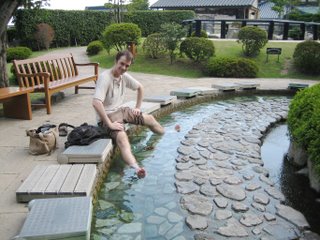 Later that afternoon, after we had made our way around 6 of the attrations, we heard a storm approaching and took shelter in a little restaurant, hoping that the rain would subside in the meantime.
Later that afternoon, after we had made our way around 6 of the attrations, we heard a storm approaching and took shelter in a little restaurant, hoping that the rain would subside in the meantime.It didn't, so we gave up on visiting the final two attractions which we further away from the 6 we had just been to, and took a bus back to Beppu station, and went to check into the hotel.
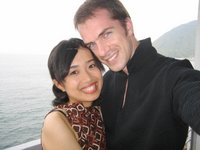 We arrived at our hotel a little bit on the early side, having again having had a long day got washed up in advance of dinner.
We arrived at our hotel a little bit on the early side, having again having had a long day got washed up in advance of dinner.Our room was a sea front one, but due to the stormy weather we didn't really have such a great view in the evening.
We took a stroll outside along the waterfront to kill time before our appointed dinner time.
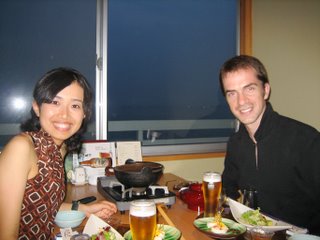

As you can see, it was quite a flash dinner. After chowing down, this being a hot spring town we had another bath before retiring for the evening. We'd leave early the next morning to catch a train so that we could spend the best part of the day in Hiroshima, back on Japan's main island of Honshu. Stay tuned!
Labels: Kana and I, Summer Holiday 2006
Summer Holiday 2006 - Day 5
After running around like tourists for the first 4 days, our plan for today was to basically take it easy, and do the "city thing" in Kagoshima. This evening we were scheduled to take a night bus from 23:00 all the way from the south of Kyushuu to Oita in the north-east, arriving the next morning by around 07:00, so nothing too adventurous was on the cards today, just relaxation.
It was a great day though, although not so much to write about from a tourist perspective. After a big late breakfast with lots of orange juice, we left the hotel in Ibusuki at around 10:00, taking a cab ride to the station, where (conveniently!) some local alcoholic beverages and some not-so-local alcoholic beverages were available. I decided that we should sample a little of both, to keep us amused during the 1 hour train ride back up the harbour to Kagoshima city.
Southern Kyushu is famous for "imo-jochu", which is basically Japanese whiskey made from potatoes. It's pretty popular up here in Tokyo as well, but it was of course my duty to sample some nonetheless. You know, to pour some tourist money into the local economy.
After the train arrived in Kagoshima, we first found our way from the station back towards the city center, where we had come back on Day 1.
I mentioned at the time that Kana had spotted some "shirokuma" dessert which apparently originated out of Kagoshima. Kana loves her sweet food (and french fries too actually), and I wasn't adverse to having some either on a hot day like this, so after looking around the city centre and shopping malls etc. we found our way back to the shop which apparently started it all - the home of the polar bear dessert...
How about that... Of course, the dessert isn't quite that big - but still massive. We were having a late lunch around 14:00, so we had some ramen again (and I thought it wise to sample the lunch beer), before tucking into some of this fancy dessert. In the meantime, lots of people came into the shops and ordered shirokuma themselves, and despite being massive big things these kids were woofing them down pretty fast.
And then, it was our turn...
Yessireee, this was a big dessert, and a mighty tasty one at that. Having just had lunch, we decided to share.
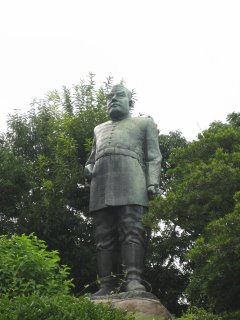 Kagoshima is famous also as the place of Saigo Takamori. Anyone who saw the Tom Cruise movie, "The Last Samurai" may be somewhat familiar with this character, because the main Samurai character in that story was actually based upon Saigo, although the movie version didn't include any of Saigo's significant nastier points, like having a desire to go off and invade the Korean peninsula for political reasons.
Kagoshima is famous also as the place of Saigo Takamori. Anyone who saw the Tom Cruise movie, "The Last Samurai" may be somewhat familiar with this character, because the main Samurai character in that story was actually based upon Saigo, although the movie version didn't include any of Saigo's significant nastier points, like having a desire to go off and invade the Korean peninsula for political reasons.This statue is the one of Saigo down in Kagoshima. There is another famous one in Ueno park here in Tokyo - obviously a man who had a lot of influence at the time.
Later that night around 18:00, we went to a recently released animated movie from Japan's equivalent of Disney, which had a nice theme song, but was otherwise pretty disappointing for Kana. I didn't really think it was that great either, but then my expectations were not as high, not having been brought up with the movies from this studio.
We then had a light meal at a Warawara restaurant (a cheap drinking / eating chain that you can find almost anywhere here in Japan) before heading to the bus station to get ready for our night ride.
When we woke up the next morning, we would be up on the other side of the island. Our next stop was Beppu, famous for hotsprings and stuff like that - the same as Rotorua in New Zealand. See you again!
Labels: Kana and I, Summer Holiday 2006
9/09/2006
Summer Holiday 2006 - Day 4
But anyway, we also took the opportunity to take some photos of Mt. Mocchomu in the background. The young inn manager had been telling us the previous night of how the mountain protects them against the natural elements quite well. Apparently on the north side of the island at Miya-no-ura, it snows in winter, but not so down here on the south with the protection of the mountain.
 The building you see here wasn't the one where we stayed. That is the building to the rear-most of the lodge complex, we stayed in the building closest to the entrance. All together I suppose there were probably 4 or 5 buildings, of differing size.
The building you see here wasn't the one where we stayed. That is the building to the rear-most of the lodge complex, we stayed in the building closest to the entrance. All together I suppose there were probably 4 or 5 buildings, of differing size.Our plan for today was to see some more of Yakushima before catching our Toppy ferry back to Ibusuki on the Kyushu mainland at 16:30.
Shiratani-unsuikyo was easily accessible from Miya-no-ura, which was the port where we had arrived on Day 2, and from which we would depart later in the afternoon today.
We gunned our speedy rent-a-car, which was of course still waiting for us at the lodge where we parked it on the evening of Day 2, back to the north side of the island. Eventually we found the road that would take us up the hill to the walk route, and took some mental notes about gas stations along the way (we needed to fill the tank back up when we dropped off the car later). As we arrived near the walk entrance, some guys were there directing the parking traffic. We had our car allocated a spot just off the road under the shelter of a tree. From there it was just a short walk to the park entrance, and we began our walk by around 11 am.
 This walk was generally similar to the Jomon Sugi climb, although perhaps a little easier, and the forest itself seemed a little less dense here.
This walk was generally similar to the Jomon Sugi climb, although perhaps a little easier, and the forest itself seemed a little less dense here. As per the photo, there were various spots to take in some negative ions along the way.
According to the guide pamphlets that we got here, there was a choice in routes, so it was a good place to go if you need to fit something in for a few hours. There was a 5 hour walk, but we opted for a shorter 3 hour version which didn't go so far up the ravine. This worked out nicely for us, as we had seats on the ferry booked later in the afternoon.
But anyway, we walked up the ravine, and back down again. I'm going to let the pictures do the talking here:


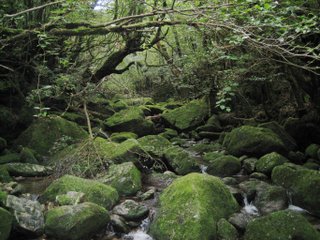
Eventually we reached the "Mononoke-hime" spot, where we would turn around and go back down. We met another couple who were just doing their first walk here today. They were wondering about how it compared with the Jomon Sugi climb. Of course, both attractions had their own merits and it was really worth going to see both of them if you have the time (and energy!) to do so.
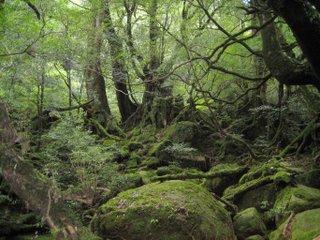
 After a couple of hours in the bush we walked back down the hill, climbing over massive rock faces etc, and exited the walk area and returned to the car.
After a couple of hours in the bush we walked back down the hill, climbing over massive rock faces etc, and exited the walk area and returned to the car.Shortly after take-off, we spotted a small water fountain on the side of the road. This water is a little bit special - it's water of longevity, and being a little thirsty we had a bottle then and there, and took another for the road.
We drove back down the hill (taking some pictures where there was a nice vantage point of the ocean) and returned to the tourist complex we had been to early on Day 2 to have some lunch.
After tanking the car up with gas, we dropped the car off at the ferry carpark as instructed, and boarded our ferry back to Kyushu, but not before buying some more tasty tankan juice at the souvenir shop there.
The ferry ride back to Kyushu was again pretty smooth, although we seemed to be shielded from higher seas by Tanegashima to the East, where we made a short stop before continuing on to Ibusuki.
 We arrived there shortly after 18:00, and the Toppy staff had kindly arranged for a taxi to meet us at the port. We had the driver take us to the Phoenix Hotel, where I had booked us in for a night's stay, which included a ticket to a sand-steam bath, which is the main attraction in Ibusuki. Apparently in Ibusuki there are hot springs that warm the waters and the sand on the beach, so instead of taking a hot bath of water you get buried into the sand and have a kind of sauna that way.
We arrived there shortly after 18:00, and the Toppy staff had kindly arranged for a taxi to meet us at the port. We had the driver take us to the Phoenix Hotel, where I had booked us in for a night's stay, which included a ticket to a sand-steam bath, which is the main attraction in Ibusuki. Apparently in Ibusuki there are hot springs that warm the waters and the sand on the beach, so instead of taking a hot bath of water you get buried into the sand and have a kind of sauna that way.The taxi driver was a nice talkative old fellow with a strong local accent, and he tried to offer his transportation services to us for the next day, but we'd already decided to spend it back in Kagoshima.
 We checked in, and took a stroll around the hotel grounds (it was a resort style kind of place), enjoyed the nice moon view, before heading back for dinner at 19:30.
We checked in, and took a stroll around the hotel grounds (it was a resort style kind of place), enjoyed the nice moon view, before heading back for dinner at 19:30.By around 21:00 we were done with dinner and made our way to the sand bath, which was connected to the hotel itself. After changing into some sand bathing robes, Kana and I were buried in the sand alongside each other, where we steamed away for several minutes. This sand bath was actually attached to the resort hotel, where as I believe that you can also have a more authentic hot sand bath on the beach, but then it was nice to have a bath under controlled temperatures.
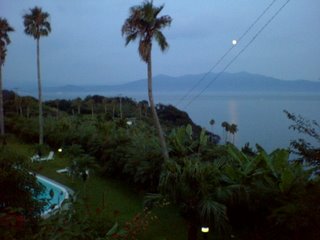
Labels: Kana and I, Summer Holiday 2006
9/05/2006
Whaling - Remi Parmentier
Remi Parmentier of the Varda Group, here as a special advisor to the Pew Trusts, found a real irony in Japan's current position.
"Japan is complaining about the way things have gone in the era since 1972 when the moratorium was first proposed.
"But if we conservationists had not been there at the time, successfully pushing whale conservation and the moratorium, today there would not be any scope for discussion of a resumption of commercial whaling because in all likelihood there would only be remnant populations of whales left."
As I have noted previously, the IWC had:
1) Placed depleted whale stocks including the Gray whale, the Right whale, the Blue whale, and the Humpback whale under protection before 1972 when a moratorium was first proposed (and before Greenpeace first appeared in 1971), and
2) Scientists such as the FAO's John Gulland noted at the time the moratorium was imposed that whaling catches by that time were "by and large, within the productive capacity of the stock" and were believed to be "sustainable indefinitely".
It is very difficult to reconcile Mr. Parmentier's assertion as reported by the BBC with these points.
Additionally, it's again worth remembering what "conservation" means. One definition from www.dictionary.com is:
the careful utilization of a natural resource in order to prevent depletion.Given that Parmentier promoted the moratorium (despite there never being any advice from the IWC Scientific Committee that the measure was necessary), and that conservation implies the utilization of resources (as opposed to no utilization) one wonders by what definition of "conservation" Parmentier sees himself as a conservationist.
The pendulum is swinging however. We've seen the extreme of over-hunting until the 1970's, followed by the opposite extreme of over-protection since the 1980's. Today the balance is shifting back to the more moderate center, where more and more nations now agree that limited conservative whaling is possible for abundant stocks, while still depleted stocks should remain protected.
Reminding the western media of the true meaning of conservation is likely an important key in achieving a rational debate about this issue.
Archives
June 2004 July 2004 August 2004 September 2004 October 2004 November 2004 December 2004 January 2005 March 2005 April 2005 May 2005 June 2005 July 2005 August 2005 September 2005 October 2005 November 2005 December 2005 January 2006 February 2006 March 2006 April 2006 May 2006 June 2006 July 2006 August 2006 September 2006 October 2006 November 2006 December 2006 January 2007 February 2007 March 2007 April 2007 May 2007 June 2007 July 2007 August 2007 September 2007 October 2007 November 2007 December 2007 January 2008 February 2008 April 2008 May 2008 June 2008 July 2008 August 2008 September 2008 October 2008 November 2008 December 2008 January 2009 February 2009 March 2009 April 2009 May 2009 June 2009 July 2009 August 2009 September 2009 October 2009 November 2009 January 2010 February 2010 April 2010 May 2010 June 2010 July 2010 August 2010 September 2010 February 2011 March 2011 May 2013 June 2013
